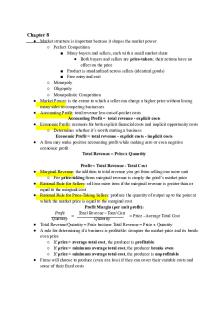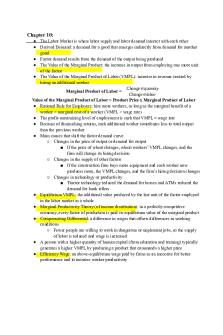Micro Econ Chapter 8 Lecture Notes PDF

| Title | Micro Econ Chapter 8 Lecture Notes |
|---|---|
| Course | Intro To Microeconomics |
| Institution | Indiana University - Purdue University Indianapolis |
| Pages | 5 |
| File Size | 328.7 KB |
| File Type | |
| Total Downloads | 4 |
| Total Views | 259 |
Summary
Chapter 8● Market structure is important because it shapes the market power ○ Perfect Competition ■ Many buyers and sellers, each with a small market share ● Both buyers and sellers are price-takers ; their actions have no effect on the price ■ Product is standardized across sellers (identical goods...
Description
Chapter 8 ● Market structure is important because it shapes the market power ○ Perfect Competition ■ Many buyers and sellers, each with a small market share ● Both buyers and sellers are price-takers; their actions have no effect on the price ■ Product is standardized across sellers (identical goods) ■ Free entry and exit ○ Monopoly ○ Oligopoly ○ Monopolistic Competition ● Market Power: is the extent to which a seller can charge a higher price without losing many sales to competing businesses ● Accounting Profit: total revenue less out-of-pocket costs Accounting Profit = total revenue - explicit costs ● Economic Profit: accounts for both explicit financial costs and implicit opportunity costs ○ Determines whether it’s worth starting a business Economic Profit = total revenue - explicit costs - implicit costs ● A firm may make positive accounting profit while making zero or even negative economic profit Total Revenue = Price x Quantity
● ● ●
● ●
●
Profit = Total Revenue - Total Cost Marginal Revenue: the addition to total revenue you get from selling one more unit ○ For price-taking firms marginal revenue is simply the good’s market price Rational Rule for Sellers: sell one more item if the marginal revenue is greater than or equal to the marginal cost Rational Rule for Price-Taking Sellers: produce the quantity of output up to the point at which the market price is equal to the marginal cost Profit Margin (per unit profit): Profit Total Revenue−Total Cost = = Price - Average Total Cost Quantity Quantity Total Revenue/Quantity = Price because Total Revenue = Price x Quantity A rule for determining if a business is profitable: compare the market price and its breakeven price ○ If price > average total cost, the producer is profitable ○ If price = minimum average total cost, the producer breaks even ○ If price < minimum average total cost, the producer is unprofitable Firms will choose to produce (even at a loss) if they can cover their variable costs and some of their fixed costs
● Shut-down Price: minimum average variable cost ● Firms will stop producing in the short run if the market price falls below the shut-down price ○ So, the marginal cost curve above shut-down price is the firm’s short-run supply curve
● Rational Rule for Entry: enter a market if you expect price > average total cost ● Rational Rule for Exit: exit the market if you expect price < average total cost ● In the long run, with free entry and exit, price equals average cost; economic profit is zero ● A perfectly competitive industry can have profits in the short run, but not in the long run in the long run, any profit in this industry will compete away as new firms enter the market ○ Contrast: barriers to entry allow a monopolist to make profits in both the short and long run
● Firm Demand Curve: summarizes the quantity that buyers demand from an individual firm as it changes its price
○ Depends on the type of competition they face
● Perfectly Competitive Firms: ○ each of the firm’s demand curve is perfectly elastic ○ Marginal revenue is simply the market price ○ Cannot choose a price: firm demand curve is flat ● Monopolists: ○ The demand curve is the market demand curve, which slopes downward ○ A wedge between the price of the good and the marginal revenue ○ Can choose a price: firm demand curve is downward sloping ■ Producers can charge a higher price for a lower quantity ○ An increase in production has two opposing effects on revenue: ■ Quantity Effect: one more unit is sold, increasing total revenue by the price at which the unit is sold ■ Price Effect: to sell the last unit, the firm must cut the market price on all units sold; decreases total revenue
● Price Discrimination: charging different prices to different consumers for the same good ● Perfect Price Discrimination: firms will charge each customer a different price, the maximum each is willing to pay ● Profits will not persist in the long run unless there is a barrier to entry...
Similar Free PDFs

Chapter 8 - Lecture notes 8
- 7 Pages

Chapter 8 - Lecture notes 8
- 2 Pages

Chapter 8 - Lecture notes 8
- 7 Pages

Chapter 8 - Lecture notes 8
- 2 Pages

Chapter 8 lecture notes
- 1 Pages

Chapter 8 - lecture notes
- 9 Pages
Popular Institutions
- Tinajero National High School - Annex
- Politeknik Caltex Riau
- Yokohama City University
- SGT University
- University of Al-Qadisiyah
- Divine Word College of Vigan
- Techniek College Rotterdam
- Universidade de Santiago
- Universiti Teknologi MARA Cawangan Johor Kampus Pasir Gudang
- Poltekkes Kemenkes Yogyakarta
- Baguio City National High School
- Colegio san marcos
- preparatoria uno
- Centro de Bachillerato Tecnológico Industrial y de Servicios No. 107
- Dalian Maritime University
- Quang Trung Secondary School
- Colegio Tecnológico en Informática
- Corporación Regional de Educación Superior
- Grupo CEDVA
- Dar Al Uloom University
- Centro de Estudios Preuniversitarios de la Universidad Nacional de Ingeniería
- 上智大学
- Aakash International School, Nuna Majara
- San Felipe Neri Catholic School
- Kang Chiao International School - New Taipei City
- Misamis Occidental National High School
- Institución Educativa Escuela Normal Juan Ladrilleros
- Kolehiyo ng Pantukan
- Batanes State College
- Instituto Continental
- Sekolah Menengah Kejuruan Kesehatan Kaltara (Tarakan)
- Colegio de La Inmaculada Concepcion - Cebu









